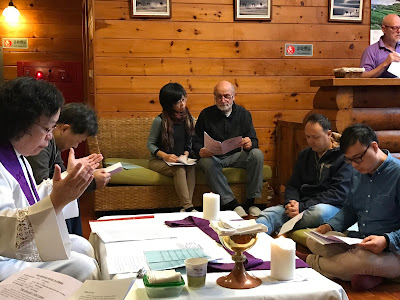Time: March 25-26, 2017 (Saturday and Sunday)
Place: Linhu Villa B&B, in Lugu, Nantou County
(Address: 南投縣鹿谷鄉永隆村窟邊巷5之2號)
During our retreat this year, we had something special: An Instructed Eucharist. -- What is an "Instructed Eucharist"? ... Since it was my first time experiencing it, I was curious about how it differed from the general (or normal) Eucharist.
In fact we had Holy Eucharist by following The Book of Common Prayer, pages 355 - 366, but with some additional "instructions" included in the service:
1) First instruction, after any opening remarks of the celebrant and just before the service begins. First of all, we are taught (or reminded of) why and how we celebrate Holy Eucharist. A Eucharistic service has two main parts. The first part is known as the "Service of the Word" or the "Liturgy of the Word." The word liturgy means the work of the people. In the Liturgy of the Word we gather in the Lord's name, proclaim and respond to the Word of God, and pray for the world and the church.
As guided on page 356, BCP, we usually sing a hymn of praise, Glory to God, which has been used for centuries in the gathering rite. But since it's now in the season of Lent, we sang Kyrie eleison instead.
2) Second instruction, between the Collect (Prayer) of the Day and the reading of the first lesson. In this part of the Liturgy of the word we sit in order to listen to readings from the Bible. It is our custom to stand, sit, or kneel at different parts of the service.
To help us learn more about our physical positions during the service, David Puckett (our music director) gave us these easy-to-remember phrases: "Sit to listen, stand to proclaim, and kneel to confess." It's true that we stand to sing or to pray in the church, but here in the villa (What a cozy room!) we remained sitting even when we were singing.
3) Third instruction, after the Nicene Creed. In the last portion of the Liturgy of the Word, we pray for the church and for the world. Our prayers always include the entire universal Church, the nation, the welfare of the world, the concerns of the local community, those who suffer or are in trouble, and those who have died. When the prayers are concluded, we say together a general confession of our sins and listen as the celebrant pronounces God's forgiveness. Then we are prepared to exchange God's Peace. The ancient custom of passing the Peace expresses our unity in Christ and our readiness to receive Communion.
4) Fourth instruction, after the exchange of the Peace and after any announcements, but before the Offertory. We begin the Liturgy of the Table, or Holy Communion, by accepting the people's offerings of bread, wine, money, and other gifts.
5) Fifth instruction, after the altar is completely ready and just before the celebrant begins. The word Eucharist means to give thanks. In the communion service Christians tell the story of God's creation and God's saving act of redemption by the sending of Jesus. We focus on the death and resurrection of Jesus which is the heart of the Christian faith. We listen to his oldest recorded words at the Last Supper with his disciples, in which he commanded us to continue the tradition he was beginning.
"First he [Jesus] took the bread. Then he gave thanks over the bread. He broke the bread, and finally he gave it to the people." As we involve ourselves in the drama of communion, together we remember what happened in such a vivid way that this memory is brought right back into the present moment.
6) Sixth instruction, after the celebrant has broken the bread and the fraction anthem has been sung, but before the words of invitation. Through all of our prayers, we believe that God has now transformed the bread and wine so that Christ is truly present in them. Together they are an outward and visible sign of an inward and spiritual grace -- the traditional definition of a sacrament.
7) Seventh instruction, after any communion anthem or music is finished, while the last of the altar is being cleared. The deacon (or priest) clears the altar in much the same way as we might clear our own table after dinner, removing the dishes and cloths and eating or storing any leftovers. The celebrant then leads everyone in saying a post-communion prayer, followed by a hymn and a closing procession. The final act of our common worship is the dismissal, which formally closes the worship with a call for us to go as Christ's servants out into the world. It reminds us that the purpose of worship is not simply to encourage and build ourselves up, but for all of us to be empowered and sent forth as ministers of Christ.















































沒有留言:
張貼留言